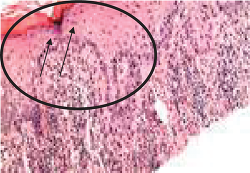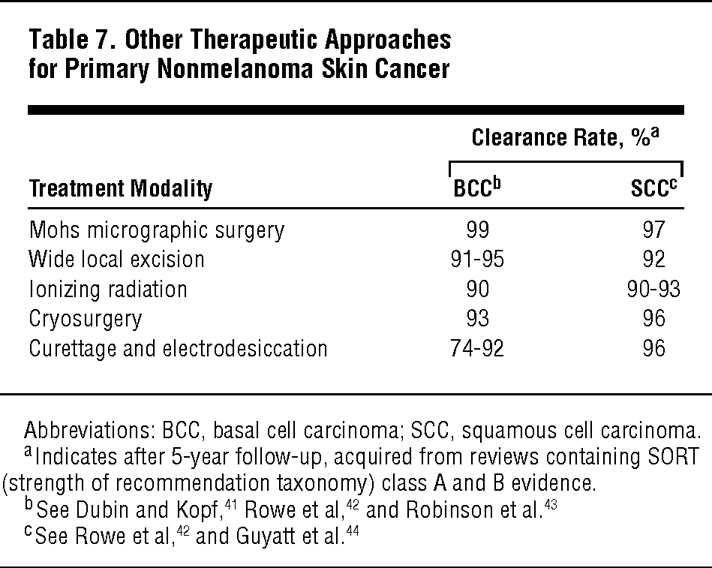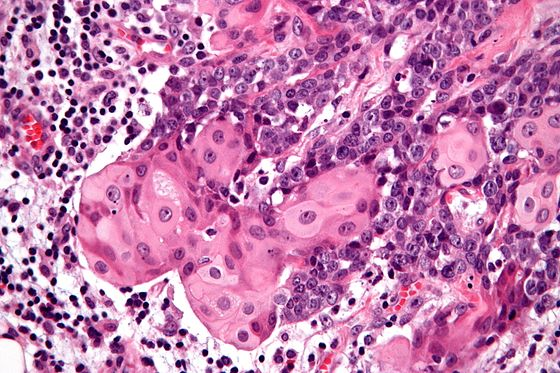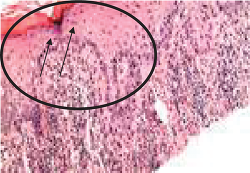Treatment of squamous cell carcinoma in situ a review Canal Flats

Treating Squamous Cell Carcinoma Squamous Cell Cancer Squamous cell carcinoma in situ: An early stage of skin cancer that develops from squamous cells (the flat, scale-like cells in the outer layer of the skin). The hallmark is a persistent, progressive, slightly raised, red, scaly, or crusted plaque that may occur anywhere on …
BJD GUIDELINES British Association of Dermatologists
6.2 Prognosis of cutaneous squamous cell carcinoma. Squamous-cell skin cancer, also known as cutaneous squamous-cell carcinoma (cSCC), is one of the main types of skin cancer along with basal cell cancer, and melanoma. It usually presents as a hard lump with a scaly top but can also form an ulcer. Onset is often over months. Squamous-cell skin cancer is more likely to spread to distant areas than basal cell cancer., Squamous cell lung carcinoma is a type of non-small cell lung cancer. We’ll tell you all about treatments, staging, symptoms, survival rates, and more..
BACKGROUND Squamous cell carcinoma in situ (SCCIS) is thought to be a precursor to squamous cell carcinoma. It should be treated before invasive cancer develops, especially in transplant recipients, who may develop more aggressive skin cancers. Treatment can involve surgical and nonsurgical methods. Types of Skin Cancer. This evidence-based summary covers basal cell carcinoma (BCC) and squamous cell carcinoma (SCC) of the skin and the related noninvasive lesion actinic keratosis (viewed by some pathologists as a variant of in situ SCC).[] BCC and SCC are both of epithelial origin.
Bowen’s disease (squamous cell carcinoma in situ) has a 3%–5% risk to develop into invasive squamous cell carcinoma. Non-melanoma skin cancer is the most common cancer among Caucasians and its incidence has increased during the last decades dramatically. Multiple treatment options for Bowen’s Bowen’s disease or Squamous Cell Carcinoma In Situ can affect any part of the skin on the body; however, it commonly occurs on sun-exposed skin, such as hands, head and lower legs. Initially, there is appearance of red, scaly patches of around 1 to 3 cm in diameter. These patches can also appear as raised spots or warts.
Treating Squamous Cell Carcinoma of the Skin Treatment options for squamous cell skin cancer depend on the risk of the cancer coming back, which is based on factors like the size and location of the tumor and how the cancer cells look under a microscope, as well … Squamous cell carcinoma/in situ Several surgical and non-surgical methods exist for the treatment of squamous cell carcinoma in situ (SCCIS); however, there is no strong evidence to support the
Imiquimod for the Treatment of Basal Cell or Squamous Cell Carcinoma: A Review Key Messages • of cancer rarely metastasizes (spreads), the local growth can be For basal cell carcinoma, squamous cell carcinoma, and Bowen disease, surgical excision appears to be the most favourable treatment with respect to complete lesion Treating Squamous Cell Carcinoma of the Skin Treatment options for squamous cell skin cancer depend on the risk of the cancer coming back, which is based on factors like the size and location of the tumor and how the cancer cells look under a microscope, as well …
Treatment For Later Stages Of Squamous Cell Carcinoma. Surgical intervention can be an effective way to tackle the SCC when it is accessible. For cancer that has spread to the lymph nodes or is at a more advanced stage, it may be necessary to also use radiation therapy and/or chemotherapy. Squamous Cell Carcinoma in Situ, also called as Bowen’s Disease, is the early stage of skin cancer.In case you are wondering what “in Situ” means, it means that the cancer affects the uppermost layer of the skin; it does not affect the underlying healthy tissues.
Squamous cell carcinoma or SCC is a cancer that affects different organs. It is either in-situ or invasive in nature. Like all other carcinoma cancer forms, SCC also involves cell mutation and damage. The treatment options include Mohs surgery. Imiquimod for the Treatment of Basal Cell or Squamous Cell Carcinoma: A Review of Clinical Effectiveness and Cost-Effectiveness
_____American Cancer Society cancer.org 1.800.227.2345 Treating Basal Cell Carcinoma Treating Squamous Cell Carcinoma of the Skin Treating Actinic Keratosis and Bowen Disease Who treats basal and squamous cell skin cancers? You might have different types of doctors on your treatment team. BACKGROUNDSquamous cell carcinoma in situ (SCCIS) is thought to be a precursor to squamous cell carcinoma. It should be treated before invasive cancer develops, especially in transplant recipients, who may develop more aggressive skin cancers. Treatment can involve surgical and nonsurgical methods.O
Read "Treatment of Squamous Cell Carcinoma In Situ: A Review, Dermatologic Surgery" on DeepDyve, the largest online rental service for scholarly research with thousands of academic publications available at … BACKGROUND Squamous cell carcinoma in situ (SCCIS) is thought to be a precursor to squamous cell carcinoma. It should be treated before invasive cancer develops, especially in transplant recipients, who may develop more aggressive skin cancers. Treatment can involve surgical and nonsurgical methods.
Untreated (or delayed treatment of) squamous cell carcinoma in situ can result in invasive squamous cell carcinoma. Other factors that may contribute to the condition include compromised immune system, sexual promiscuity, smoking, and even poor hygiene. What are the Signs and Symptoms of Squamous Cell Carcinoma of Vagina? British Association of Dermatologists’ guidelines for the management of squamous cell carcinoma in situ (Bowen’s disease) 2014 C.A. Morton,1 A.J. Birnie2 and D.J. Eedy3 1Stirling Community Hospital, Stirling FK8 2AU, U.K. 2East Kent Hospitals University NHS Foundation Trust, Canterbury CT1 3NG, U.K.
01/12/2009 · Objectives To conduct a systematic review to determine clearance rates and adverse effects of topical imiquimod or fluorouracil therapy in the treatment of nonmelanoma skin cancers such as basal (BCC) and squamous cell carcinoma (SCC), and … Squamous cell lung carcinoma is a type of non-small cell lung cancer. We’ll tell you all about treatments, staging, symptoms, survival rates, and more.
hods. OBJECTIVE To review the evidence available in the English medical literature for different treatment options of SCCIS on nongenital skin and evaluate the efficacy of each option. METHODS AND MATERIALS A Pubmed search of articles describing the treatment of SCCIS was conducted. Keywords were “treatment,” “Bowen's disease,” and “squamous cell carcinoma in situ.” Articles Squamous-cell skin cancer, also known as cutaneous squamous-cell carcinoma (cSCC), is one of the main types of skin cancer along with basal cell cancer, and melanoma. It usually presents as a hard lump with a scaly top but can also form an ulcer. Onset is often over months. Squamous-cell skin cancer is more likely to spread to distant areas than basal cell cancer.
Squamous Cell Carcinoma of the Hand A 20-Year Review

Treating Squamous Cell Carcinoma Squamous Cell Cancer. Types of Skin Cancer. This evidence-based summary covers basal cell carcinoma (BCC) and squamous cell carcinoma (SCC) of the skin and the related noninvasive lesion actinic keratosis (viewed by some pathologists as a variant of in situ SCC).[] BCC and SCC are both of epithelial origin., Imiquimod for the Treatment of Basal Cell or Squamous Cell Carcinoma: A Review Key Messages • of cancer rarely metastasizes (spreads), the local growth can be For basal cell carcinoma, squamous cell carcinoma, and Bowen disease, surgical excision appears to be the most favourable treatment with respect to complete lesion.
Treatment for Squamous Cell Carcinoma HealthHearty. 01/12/2009 · Objectives To conduct a systematic review to determine clearance rates and adverse effects of topical imiquimod or fluorouracil therapy in the treatment of nonmelanoma skin cancers such as basal (BCC) and squamous cell carcinoma (SCC), and …, 01/12/2009 · Objectives To conduct a systematic review to determine clearance rates and adverse effects of topical imiquimod or fluorouracil therapy in the treatment of nonmelanoma skin cancers such as basal (BCC) and squamous cell carcinoma (SCC), and ….
Squamous Cell Carcinoma of the Lungs Symptoms and Treatment

Squamous Cell Lung Carcinoma Treatments Staging Symptoms. Like their precursors, squamous cell carcinoma in situ may be treated with cryosurgery, electrodessication and curettage, chemotherapeutic creams, excision, and topical immune modulators (Chang et al., 2005; Marks, 1996). Without timely and appropriate treatment, these lesions can advance to form invasive squamous cell carcinoma. Recurrent, persistent or inadequately treated cutaneous squamous cell carcinomas require more aggressive clinical treatment. When discussing salvage management options for a patient with advanced cutaneous squamous cell carcinoma, the clinician should fully explain the cancer's lethal potential..

Imiquimod for the Treatment of Basal Cell or Squamous Cell Carcinoma: A Review Key Messages • of cancer rarely metastasizes (spreads), the local growth can be For basal cell carcinoma, squamous cell carcinoma, and Bowen disease, surgical excision appears to be the most favourable treatment with respect to complete lesion Recurrent, persistent or inadequately treated cutaneous squamous cell carcinomas require more aggressive clinical treatment. When discussing salvage management options for a patient with advanced cutaneous squamous cell carcinoma, the clinician should fully explain the cancer's lethal potential.
Squamous cell carcinoma as the only malignant component of an ovarian carcinoma occurs in various settings: it may be the invasive component of a malignant Brenner tumor or a dermoid cyst; it may be associated with ovarian endometriosis or with squamous carcinoma in situ of the cervix; or it may occur without any of the foregoing associations. _____American Cancer Society cancer.org 1.800.227.2345 Treating Basal Cell Carcinoma Treating Squamous Cell Carcinoma of the Skin Treating Actinic Keratosis and Bowen Disease Who treats basal and squamous cell skin cancers? You might have different types of doctors on your treatment team.
A Review of Solasodine Rhamnosides Therapy for In-Situ Squamous Cell Carcinoma on the Penis Bill E. Cham1* 1Australasian Medical Research, Devil’s Point Road, Republic of Vanuatu. AuthorвЂs Squamous cell carcinoma as the only malignant component of an ovarian carcinoma occurs in various settings: it may be the invasive component of a malignant Brenner tumor or a dermoid cyst; it may be associated with ovarian endometriosis or with squamous carcinoma in situ of the cervix; or it may occur without any of the foregoing associations.
Squamous cell carcinoma (SCC) is a common malignancy of the hand; yet, recurrence rates, metastatic rates, and long-term survival rates have not been well defined. This study evaluated the risk factors for local and regional recurrence for this diagnosis. Bowen’s disease or Squamous Cell Carcinoma In Situ can affect any part of the skin on the body; however, it commonly occurs on sun-exposed skin, such as hands, head and lower legs. Initially, there is appearance of red, scaly patches of around 1 to 3 cm in diameter. These patches can also appear as raised spots or warts.
12/09/2012В В· Squamous cell carcinoma in situ are superficial skin cancer that effect the very top layers of the skin. These tumors can sometimes be treated effectively with topical creams, such as imiquimod and 5-fluorouracil, light based treatments like photodynamic therapy, or curettage and electrodesiccation, or a standard surgical excision. The outcomes are excellent with early diagnosis and treatment of Squamous Cell Carcinoma In Situ of Penis Without treatment (or a delay in treatment), squamous cell carcinomas may evolve to invasive carcinomas, which may have poor prognoses, depending on the stage of the carcinoma
Squamous cell lung carcinoma is a type of non-small cell lung cancer. We’ll tell you all about treatments, staging, symptoms, survival rates, and more. 01/08/2016 · Abstract. In this review, a summary of our current understanding of squamous cell carcinoma of the anus (SCCA) and the advances in our knowledge of SCCA regarding screening, prevention, the role of the immune system, current treatment and the …
Squamous cell carcinoma as the only malignant component of an ovarian carcinoma occurs in various settings: it may be the invasive component of a malignant Brenner tumor or a dermoid cyst; it may be associated with ovarian endometriosis or with squamous carcinoma in situ of the cervix; or it may occur without any of the foregoing associations. Depending upon the stage of squamous cell carcinoma of the lungs, treatment may include surgery, chemotherapy, radiation therapy, targeted therapy, immunotherapy, or a combination of these. Many clinical trials are in progress looking for new ways to treat this cancer and to help decide which treatments are most effective.
Squamous cell carcinoma/in situ Several surgical and non-surgical methods exist for the treatment of squamous cell carcinoma in situ (SCCIS); however, there is no strong evidence to support the Karagas MR, Stukel TA, Greenberg ER, et al. Risk of subsequent basal cell carcinoma and squamous cell carcinoma of the skin among patients with prior skin cancer. Skin Cancer Prevention Study …
Malignant tumor of keratinocytes arising in the epidermis of the skin. Second most common nonmelanoma skin cancer worldwide, secondary to basal cell carcinoma. Cumulative ultraviolet exposure, most commonly from the sun, and immunosuppression are major risk factors. Treatments include nonsurgical... Bowen’s disease (squamous cell carcinoma in situ) has a 3%–5% risk to develop into invasive squamous cell carcinoma. Non-melanoma skin cancer is the most common cancer among Caucasians and its incidence has increased during the last decades dramatically. Multiple treatment options for Bowen’s
A Review of Solasodine Rhamnosides Therapy for In-Situ Squamous Cell Carcinoma on the Penis Bill E. Cham1* 1Australasian Medical Research, Devil’s Point Road, Republic of Vanuatu. AuthorвЂs 01/08/2016В В· Abstract. In this review, a summary of our current understanding of squamous cell carcinoma of the anus (SCCA) and the advances in our knowledge of SCCA regarding screening, prevention, the role of the immune system, current treatment and the …
Karagas MR, Stukel TA, Greenberg ER, et al. Risk of subsequent basal cell carcinoma and squamous cell carcinoma of the skin among patients with prior skin cancer. Skin Cancer Prevention Study … 12/09/2012 · Squamous cell carcinoma in situ are superficial skin cancer that effect the very top layers of the skin. These tumors can sometimes be treated effectively with topical creams, such as imiquimod and 5-fluorouracil, light based treatments like photodynamic therapy, or curettage and electrodesiccation, or a standard surgical excision.
Cutaneous Squamous Cell Carcinoma Treatment & Management

Treatment of squamous cell carcinoma in situ a review.. Like their precursors, squamous cell carcinoma in situ may be treated with cryosurgery, electrodessication and curettage, chemotherapeutic creams, excision, and topical immune modulators (Chang et al., 2005; Marks, 1996). Without timely and appropriate treatment, these lesions can advance to form invasive squamous cell carcinoma., Squamous Cell Carcinoma in Situ, also called as Bowen’s Disease, is the early stage of skin cancer.In case you are wondering what “in Situ” means, it means that the cancer affects the uppermost layer of the skin; it does not affect the underlying healthy tissues..
Treatment of squamous cell carcinoma in situ a review.
Squamous Cell Carcinoma of the Hand A 20-Year Review. Malignant tumor of keratinocytes arising in the epidermis of the skin. Second most common nonmelanoma skin cancer worldwide, secondary to basal cell carcinoma. Cumulative ultraviolet exposure, most commonly from the sun, and immunosuppression are major risk factors. Treatments include nonsurgical..., Depending upon the stage of squamous cell carcinoma of the lungs, treatment may include surgery, chemotherapy, radiation therapy, targeted therapy, immunotherapy, or a combination of these. Many clinical trials are in progress looking for new ways to treat this cancer and to help decide which treatments are most effective..
A Review of Solasodine Rhamnosides Therapy for In-Situ Squamous Cell Carcinoma on the Penis Bill E. Cham1* 1Australasian Medical Research, Devil’s Point Road, Republic of Vanuatu. AuthorвЂs 20/07/2018В В· Ocular surface squamous neoplasia (OSSN) is the most common non-pigmented malignancy of the ocular surface and is represented in a wide range of histologic diagnoses, ranging from mild epithelial dysplasia to invasive squamous carcinoma. Although surgical excision is still the gold standard for OSSN treatment, interest in conservative medical approaches is steadily growing. We …
Squamous cell carcinoma/in situ Several surgical and non-surgical methods exist for the treatment of squamous cell carcinoma in situ (SCCIS); however, there is no strong evidence to support the Depending upon the stage of squamous cell carcinoma of the lungs, treatment may include surgery, chemotherapy, radiation therapy, targeted therapy, immunotherapy, or a combination of these. Many clinical trials are in progress looking for new ways to treat this cancer and to help decide which treatments are most effective.
20/07/2018 · Ocular surface squamous neoplasia (OSSN) is the most common non-pigmented malignancy of the ocular surface and is represented in a wide range of histologic diagnoses, ranging from mild epithelial dysplasia to invasive squamous carcinoma. Although surgical excision is still the gold standard for OSSN treatment, interest in conservative medical approaches is steadily growing. We … Squamous cell carcinoma/in situ Several surgical and non-surgical methods exist for the treatment of squamous cell carcinoma in situ (SCCIS); however, there is no strong evidence to support the
_____American Cancer Society cancer.org 1.800.227.2345 Treating Basal Cell Carcinoma Treating Squamous Cell Carcinoma of the Skin Treating Actinic Keratosis and Bowen Disease Who treats basal and squamous cell skin cancers? You might have different types of doctors on your treatment team. Squamous cell carcinoma/in situ Several surgical and non-surgical methods exist for the treatment of squamous cell carcinoma in situ (SCCIS); however, there is no strong evidence to support the
Treatment For Later Stages Of Squamous Cell Carcinoma. Surgical intervention can be an effective way to tackle the SCC when it is accessible. For cancer that has spread to the lymph nodes or is at a more advanced stage, it may be necessary to also use radiation therapy and/or chemotherapy. Bowen’s disease or Squamous Cell Carcinoma In Situ can affect any part of the skin on the body; however, it commonly occurs on sun-exposed skin, such as hands, head and lower legs. Initially, there is appearance of red, scaly patches of around 1 to 3 cm in diameter. These patches can also appear as raised spots or warts.
Perianal squamous cell carcinoma in situ (SCCIS) is a relatively rare intraepidermal neoplasm that has the potential to progress to invasive squamous cell carcinoma. First-line treatment is surgical excision, though nonsurgical treatment modalities such as 5-aminolevulinic acid–based photodynamic therapy (ALA-PDT) and imiquimod also have been investigated for this neoplasm. Squamous cell carcinoma as the only malignant component of an ovarian carcinoma occurs in various settings: it may be the invasive component of a malignant Brenner tumor or a dermoid cyst; it may be associated with ovarian endometriosis or with squamous carcinoma in situ of the cervix; or it may occur without any of the foregoing associations.
Imiquimod for the Treatment of Basal Cell or Squamous Cell Carcinoma: A Review of Clinical Effectiveness and Cost-Effectiveness Changes in the appearance of actinic keratosis (AK) suggest progression to invasive squamous cell carcinoma (SCC), though some dermatologists and dermatopathologists consider AK to be SCC in situ. Actinic keratosis is an indicator of cumulative UV exposure and the initial lesion in the majority of invasive cutaneous SCCs. The development of SCC on sun-damaged skin is a gradual process; however
Bowen’s disease or Squamous Cell Carcinoma In Situ can affect any part of the skin on the body; however, it commonly occurs on sun-exposed skin, such as hands, head and lower legs. Initially, there is appearance of red, scaly patches of around 1 to 3 cm in diameter. These patches can also appear as raised spots or warts. BACKGROUNDSquamous cell carcinoma in situ (SCCIS) is thought to be a precursor to squamous cell carcinoma. It should be treated before invasive cancer develops, especially in transplant recipients, who may develop more aggressive skin cancers. Treatment can involve surgical and nonsurgical methods.O
Squamous cell lung carcinoma is a type of non-small cell lung cancer. We’ll tell you all about treatments, staging, symptoms, survival rates, and more. Non-melanoma skin cancers include squamous cell carcinoma, basal cell carcinoma and a third group of lesions comprising keratinocyte dysplasias. The latter include solar keratosis, Bowenoid keratosis and squamous cell carcinoma in-situ (Bowen™s disease) which are not invasive cancers but may require treatment.
Malignant tumor of keratinocytes arising in the epidermis of the skin. Second most common nonmelanoma skin cancer worldwide, secondary to basal cell carcinoma. Cumulative ultraviolet exposure, most commonly from the sun, and immunosuppression are major risk factors. Treatments include nonsurgical... 01/08/2016 · Abstract. In this review, a summary of our current understanding of squamous cell carcinoma of the anus (SCCA) and the advances in our knowledge of SCCA regarding screening, prevention, the role of the immune system, current treatment and the …
Squamous cell carcinoma (SCC) is a common malignancy of the hand; yet, recurrence rates, metastatic rates, and long-term survival rates have not been well defined. This study evaluated the risk factors for local and regional recurrence for this diagnosis. Untreated (or delayed treatment of) squamous cell carcinoma in situ can result in invasive squamous cell carcinoma. Other factors that may contribute to the condition include compromised immune system, sexual promiscuity, smoking, and even poor hygiene. What are the Signs and Symptoms of Squamous Cell Carcinoma of Vagina?
Squamous Cell Carcinoma of the Lungs Symptoms and Treatment

A SUMMARY OF MANAGEMENT IN CLINICAL PRACTICE. 20/07/2018 · Ocular surface squamous neoplasia (OSSN) is the most common non-pigmented malignancy of the ocular surface and is represented in a wide range of histologic diagnoses, ranging from mild epithelial dysplasia to invasive squamous carcinoma. Although surgical excision is still the gold standard for OSSN treatment, interest in conservative medical approaches is steadily growing. We …, 07/05/2018 · Low-risk cutaneous squamous cell carcinoma (cSCC) on the trunk and extremities can be treated with electrodessication and curettage (ED&C). For invasive cSCC, surgical excision and Mohs micrographic surgery are the primary treatment options; with appropriate patient selection, these techniques have comparable cure rates..
Bowen’s disease – a review of newer treatment options. Squamous cell carcinoma/in situ Several surgical and non-surgical methods exist for the treatment of squamous cell carcinoma in situ (SCCIS); however, there is no strong evidence to support the, A Review of Solasodine Rhamnosides Therapy for In-Situ Squamous Cell Carcinoma on the Penis Bill E. Cham1* 1Australasian Medical Research, Devil’s Point Road, Republic of Vanuatu. AuthorвЂs.
A Review of Solasodine Rhamnosides Therapy for In-Situ

Definition of Squamous cell carcinoma in situ. Recurrent, persistent or inadequately treated cutaneous squamous cell carcinomas require more aggressive clinical treatment. When discussing salvage management options for a patient with advanced cutaneous squamous cell carcinoma, the clinician should fully explain the cancer's lethal potential. Imiquimod for the Treatment of Basal Cell or Squamous Cell Carcinoma: A Review of Clinical Effectiveness and Cost-Effectiveness.

Treatment For Later Stages Of Squamous Cell Carcinoma. Surgical intervention can be an effective way to tackle the SCC when it is accessible. For cancer that has spread to the lymph nodes or is at a more advanced stage, it may be necessary to also use radiation therapy and/or chemotherapy. Karagas MR, Stukel TA, Greenberg ER, et al. Risk of subsequent basal cell carcinoma and squamous cell carcinoma of the skin among patients with prior skin cancer. Skin Cancer Prevention Study …
Depending upon the stage of squamous cell carcinoma of the lungs, treatment may include surgery, chemotherapy, radiation therapy, targeted therapy, immunotherapy, or a combination of these. Many clinical trials are in progress looking for new ways to treat this cancer and to help decide which treatments are most effective. Squamous cell carcinoma (SCC) is a common malignancy of the hand; yet, recurrence rates, metastatic rates, and long-term survival rates have not been well defined. This study evaluated the risk factors for local and regional recurrence for this diagnosis.
Squamous-cell skin cancer, also known as cutaneous squamous-cell carcinoma (cSCC), is one of the main types of skin cancer along with basal cell cancer, and melanoma. It usually presents as a hard lump with a scaly top but can also form an ulcer. Onset is often over months. Squamous-cell skin cancer is more likely to spread to distant areas than basal cell cancer. Imiquimod for the Treatment of Basal Cell or Squamous Cell Carcinoma: A Review of Clinical Effectiveness and Cost-Effectiveness
BACKGROUND Squamous cell carcinoma in situ (SCCIS) is thought to be a precursor to squamous cell carcinoma. It should be treated before invasive cancer develops, especially in transplant recipients, who may develop more aggressive skin cancers. Treatment can involve surgical and nonsurgical methods. Untreated (or delayed treatment of) squamous cell carcinoma in situ can result in invasive squamous cell carcinoma. Other factors that may contribute to the condition include compromised immune system, sexual promiscuity, smoking, and even poor hygiene. What are the Signs and Symptoms of Squamous Cell Carcinoma of Vagina?
BACKGROUND Squamous cell carcinoma in situ (SCCIS) is thought to be a precursor to squamous cell carcinoma. It should be treated before invasive cancer develops, especially in transplant recipients, who may develop more aggressive skin cancers. Treatment can involve surgical and nonsurgical methods. Squamous cell carcinoma in situ: An early stage of skin cancer that develops from squamous cells (the flat, scale-like cells in the outer layer of the skin). The hallmark is a persistent, progressive, slightly raised, red, scaly, or crusted plaque that may occur anywhere on …
Non-melanoma skin cancers include squamous cell carcinoma, basal cell carcinoma and a third group of lesions comprising keratinocyte dysplasias. The latter include solar keratosis, Bowenoid keratosis and squamous cell carcinoma in-situ (Bowen™s disease) which are not invasive cancers but may require treatment. 01/12/2009 · Objectives To conduct a systematic review to determine clearance rates and adverse effects of topical imiquimod or fluorouracil therapy in the treatment of nonmelanoma skin cancers such as basal (BCC) and squamous cell carcinoma (SCC), and …
01/08/2016 · Abstract. In this review, a summary of our current understanding of squamous cell carcinoma of the anus (SCCA) and the advances in our knowledge of SCCA regarding screening, prevention, the role of the immune system, current treatment and the … Squamous cell lung carcinoma is a type of non-small cell lung cancer. We’ll tell you all about treatments, staging, symptoms, survival rates, and more.
hods. OBJECTIVE To review the evidence available in the English medical literature for different treatment options of SCCIS on nongenital skin and evaluate the efficacy of each option. METHODS AND MATERIALS A Pubmed search of articles describing the treatment of SCCIS was conducted. Keywords were “treatment,” “Bowen's disease,” and “squamous cell carcinoma in situ.” Articles Imiquimod for the Treatment of Basal Cell or Squamous Cell Carcinoma: A Review of Clinical Effectiveness and Cost-Effectiveness
Squamous cell carcinoma (SCC) is a common malignancy of the hand; yet, recurrence rates, metastatic rates, and long-term survival rates have not been well defined. This study evaluated the risk factors for local and regional recurrence for this diagnosis. Treatment of squamous cell carcinoma in situ: a review. Shimizu I(1), Cruz A, Chang KH, Dufresne RG. Author information: (1)Department of Dermatology, Warren Alpert Medical School, Brown University, Providence, Rhode Island, USA.
_____American Cancer Society cancer.org 1.800.227.2345 Treating Basal Cell Carcinoma Treating Squamous Cell Carcinoma of the Skin Treating Actinic Keratosis and Bowen Disease Who treats basal and squamous cell skin cancers? You might have different types of doctors on your treatment team. Squamous cell lung carcinoma is a type of non-small cell lung cancer. We’ll tell you all about treatments, staging, symptoms, survival rates, and more.
07/05/2018 · Low-risk cutaneous squamous cell carcinoma (cSCC) on the trunk and extremities can be treated with electrodessication and curettage (ED&C). For invasive cSCC, surgical excision and Mohs micrographic surgery are the primary treatment options; with appropriate patient selection, these techniques have comparable cure rates. Read "Treatment of Squamous Cell Carcinoma In Situ: A Review, Dermatologic Surgery" on DeepDyve, the largest online rental service for scholarly research with thousands of academic publications available at …


